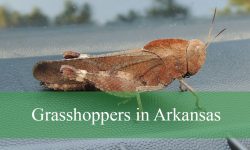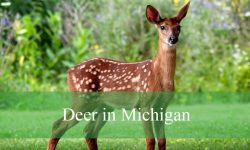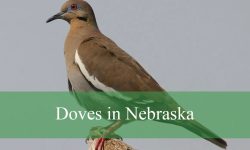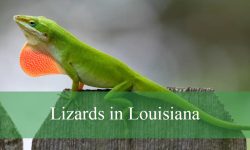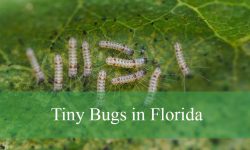With its forests, rivers, and dry plains, Idaho hosts a wide range of insects, from harmless pollinators to species that can sting or bite painfully. Most of these bugs are beneficial to nature, but a few can cause serious discomfort or transmit diseases.
Idaho’s warm summers and varied terrain make it easy for these insects to thrive in both urban and rural areas. Encounters with venomous spiders, aggressive wasps, or disease-carrying ticks can happen anywhere, from backyards to hiking trails.
This guide explores 24 of the most dangerous bugs in Idaho, explaining how to identify them, where they live, and the potential risks they pose. Learning their traits is the best way to stay safe while enjoying the outdoors.
Types of Dangerous Bugs Found in Idaho
Western Yellowjacket (Vespula pensylvanica)
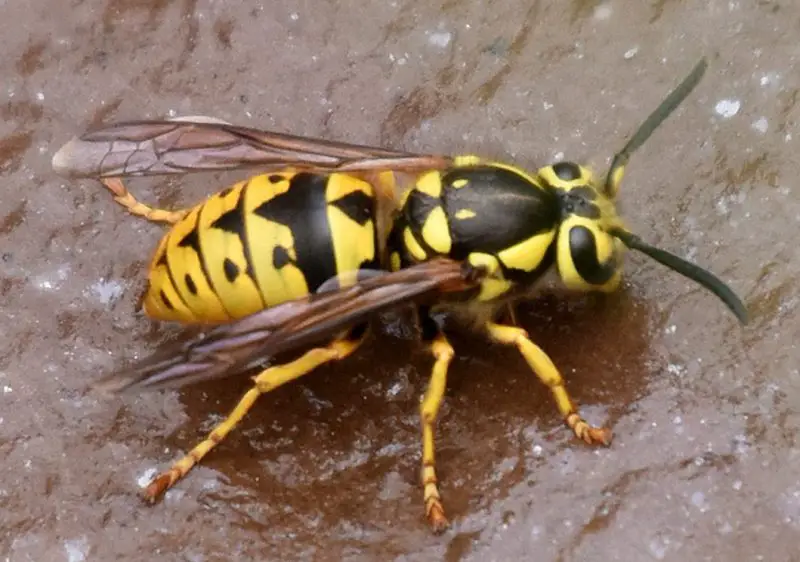
The Western Yellowjacket is one of Idaho’s most aggressive and widespread wasps. It is easily recognized by its bold yellow-and-black striped body and strong, rapid flight. Adults measure about 0.5 inches long and live in large colonies that can contain thousands of individuals by late summer.
These wasps build paper nests underground, in wall voids, or inside hollow logs. They are highly social and become increasingly defensive as the season progresses. By late summer, food shortages make them particularly aggressive around human activity, especially near picnics and garbage bins.
A Western Yellowjacket sting is extremely painful, often causing redness, swelling, and itching. Since they can sting multiple times, multiple attacks are possible if a nest is disturbed. Allergic individuals may experience severe reactions requiring immediate medical attention.
In Idaho, this species is responsible for most wasp stings reported each year. Keeping food covered, sealing trash containers, and avoiding nest areas are key precautions. Professional nest removal should always be handled with care.
Black Widow Spider (Latrodectus mactans)
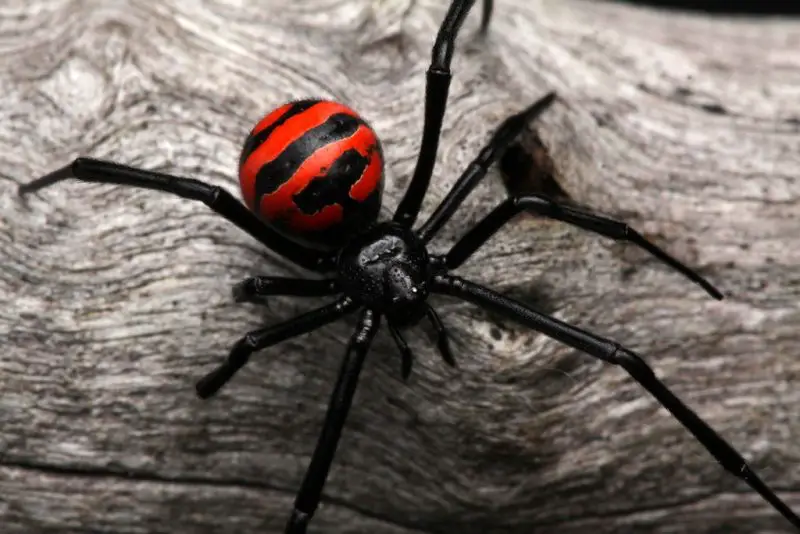
The Black Widow Spider is one of the most dangerous arachnids found in Idaho. It is easily recognized by its glossy black body and the distinctive red hourglass marking on the underside of its abdomen. Females are larger than males, measuring about 1.5 inches including their leg span. They prefer dark, sheltered places such as garages, woodpiles, and crawl spaces.
This spider is nocturnal and generally avoids human contact. However, it becomes defensive if its web or egg sacs are disturbed. The webs are irregular and sticky, usually built close to the ground. Female Black Widows are solitary and territorial, often remaining in the same location for long periods.
The venom of the Black Widow contains neurotoxins that affect the nervous system. A bite typically causes sharp, burning pain at the site, followed by muscle cramps, abdominal pain, nausea, and sometimes difficulty breathing. Although deaths are rare, medical attention should always be sought after a suspected bite.
In Idaho, these spiders are most active during the warm months from May through September. They help control insect populations but pose a serious threat to humans when encountered indoors or around outbuildings. Keeping areas clean and sealing cracks can help prevent infestations.
Brown Recluse Spider (Loxosceles reclusa)
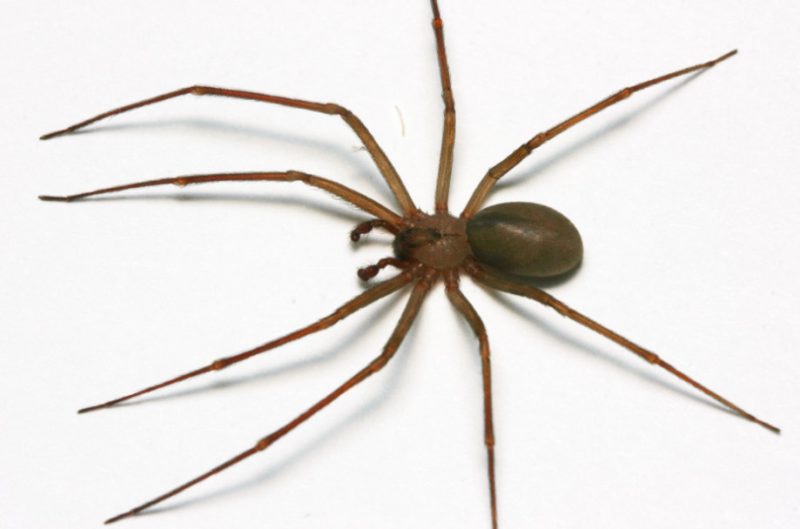
The Brown Recluse Spider is rarely encountered in Idaho, but it has been occasionally reported in the southern part of the state. This spider is identified by its light to dark brown body and a distinct violin-shaped marking on its cephalothorax. Adults typically measure between 0.25 and 0.75 inches in body length.
Brown Recluses are reclusive, as their name suggests. They prefer undisturbed environments such as basements, closets, attics, and behind furniture. Unlike most spiders, they build irregular webs and use them primarily as retreats rather than traps. They are nocturnal hunters, preying on small insects.
A bite from a Brown Recluse can be extremely dangerous. The venom contains enzymes that destroy cell membranes, leading to necrotic skin lesions, open ulcers, and in severe cases, systemic symptoms like fever and chills. The wound may take weeks or even months to heal completely.
Although these spiders are not native to most of Idaho, occasional transport through shipments or moving items can lead to localized sightings. Because of their medical significance, any suspected bite should be treated as an emergency, and prompt medical care is crucial.
Hobo Spider (Eratigena agrestis)
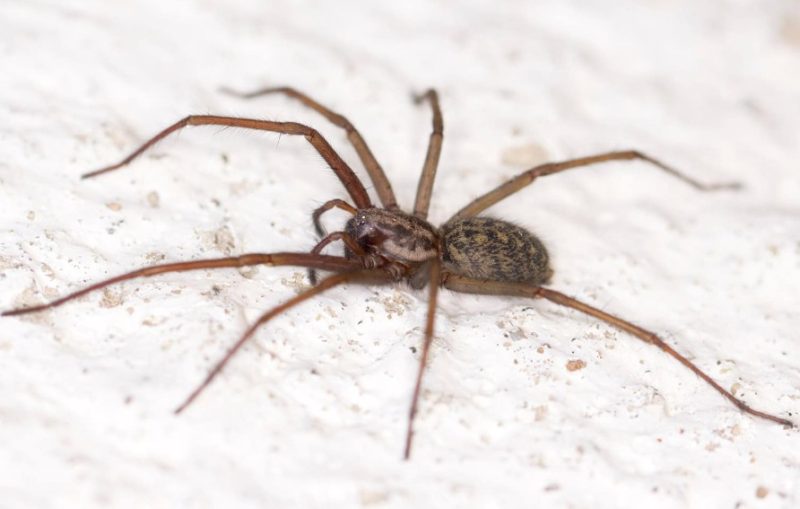
The Hobo Spider is one of Idaho’s most common house spiders. It has a brown body with lighter chevron-like markings on its abdomen and lacks any shiny or colorful patterns. Adults typically range from 0.3 to 0.6 inches in body length, with long legs that make them appear larger.
Hobo Spiders build funnel-shaped webs in cracks, corners, and basements. They are active hunters that chase prey into their webs rather than waiting passively. Although they were once thought to be aggressive, they usually only bite when trapped or threatened.
Their bite can cause mild to moderate reactions. Symptoms often include redness, swelling, and itching, though older reports of necrotic wounds have been debated by scientists. Most bites heal without medical intervention, but cleaning and monitoring the wound is important.
These spiders prefer cool, moist environments and are commonly found in basements, garages, and outdoor structures across Idaho. Despite their reputation, they play a role in controlling other household pests. Maintaining clean spaces can reduce encounters.
Yellowjacket Wasp (Vespula spp.)
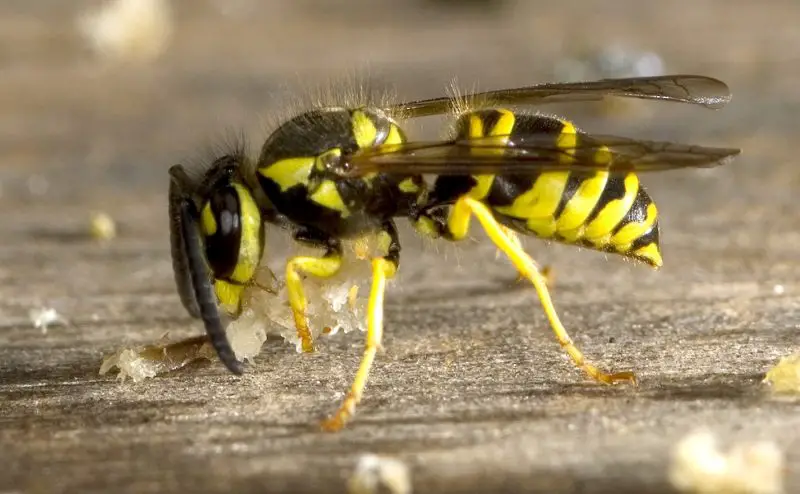
Yellowjackets are among the most aggressive stinging insects in Idaho. They are easily identified by their black-and-yellow banded bodies and rapid, darting flight patterns. Adults measure about 0.5 inches long and have a narrow waist typical of wasps.
These social insects build paper-like nests underground, in hollow trees, or inside wall cavities. Colonies can contain thousands of individuals by late summer. Yellowjackets are attracted to food and sugary drinks, making them common around picnics, garbage bins, and outdoor gatherings.
A Yellowjacket sting is extremely painful due to its venom, which contains both allergens and enzymes. Unlike bees, they can sting multiple times, injecting venom with each attack. Reactions may include swelling, redness, and severe pain. In sensitive individuals, stings can trigger anaphylaxis, a potentially fatal allergic reaction requiring immediate medical help.
In Idaho, Yellowjackets are most active during the warmer months, especially from July to September. Avoiding sweet foods outdoors and keeping trash sealed helps prevent attracting them. Professional pest control may be needed for large or hidden nests.
Bald-faced Hornet (Dolichovespula maculata)
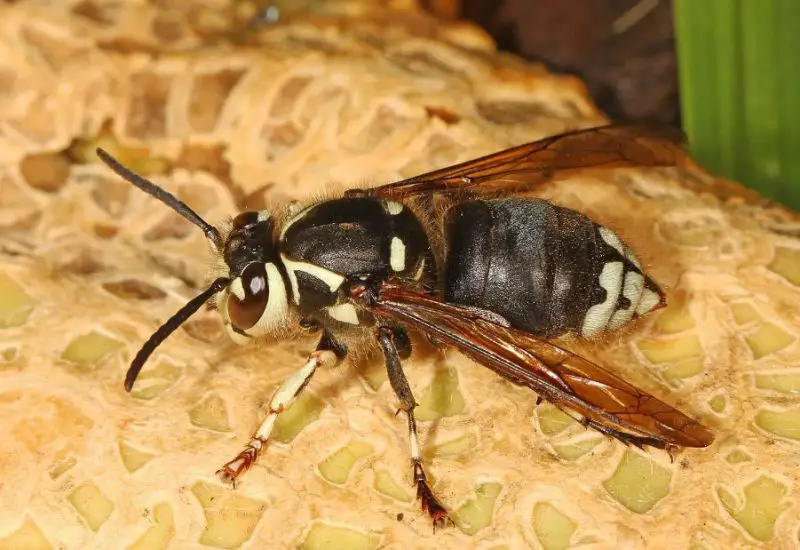
The Bald-faced Hornet, despite its name, is actually a type of large wasp. It is characterized by its black body with white facial markings and smooth, shiny appearance. Adults grow up to 0.75 inches long and have a powerful sting. Their nests are gray, papery spheres often found hanging from trees, eaves, or shrubs.
This species is highly social and extremely protective of its nest. Disturbing it can provoke a rapid, coordinated attack. The hornets are active during the day and are beneficial for controlling flies and other insects, but they become a nuisance near homes and outdoor areas.
Stings from Bald-faced Hornets are very painful and may result in significant swelling, redness, and burning sensations. Because they can sting multiple times, encounters with an entire colony can be dangerous. In allergic individuals, stings may cause severe systemic reactions and require urgent medical attention.
In Idaho, Bald-faced Hornets are active from spring through late fall. They prefer wooded areas but often build nests near human structures. Keeping a safe distance from visible nests and seeking professional removal services is essential for safety.
Paper Wasp (Polistes spp.)
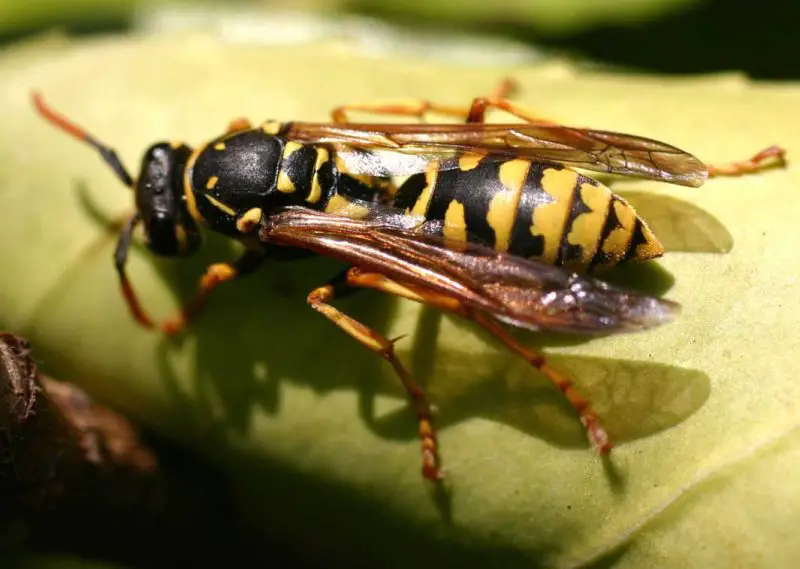
Paper Wasps are slender-bodied wasps commonly found throughout Idaho. They can be identified by their narrow waists, long legs, and reddish-brown or yellow-and-black coloration. Adults measure around 0.6 to 1 inch long. Their nests are made of papery material and have open cells, usually suspended from eaves, porch ceilings, or tree branches.
Although less aggressive than Yellowjackets or Hornets, Paper Wasps will defend their nests vigorously if threatened. They are beneficial predators, feeding on caterpillars and other soft-bodied insects that damage plants. Colonies are typically small, with a single queen and a few dozen workers.
A sting from a Paper Wasp can cause immediate pain, redness, and swelling at the site. The venom contains mild toxins that may also cause itching and burning sensations. Unlike bees, Paper Wasps can sting multiple times, and allergic individuals may experience more severe reactions.
In Idaho, these wasps are most active during warm months, particularly from late spring through early fall. Keeping outdoor areas clean and sealing openings can help prevent nesting near homes. If a nest is close to human activity, professional removal is recommended.
Velvet Ant (Dasymutilla occidentalis) — “Cow Killer Ant”
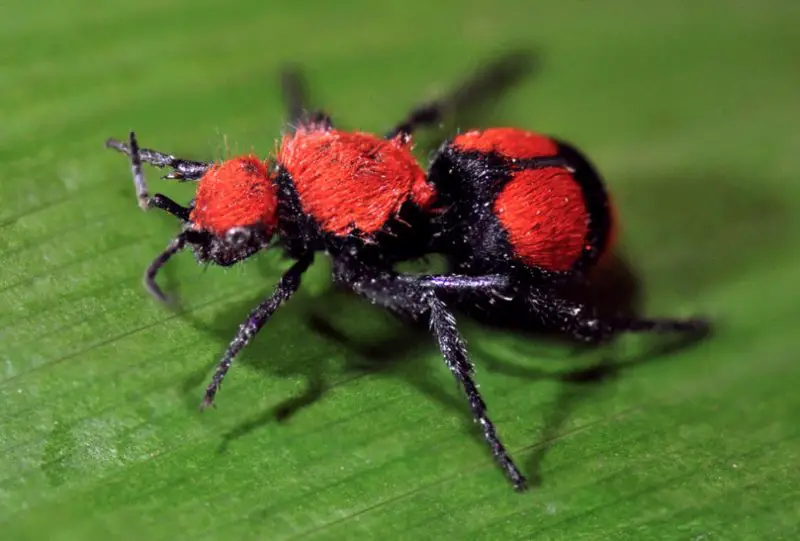
Despite its name, the Velvet Ant is not an ant but a wingless wasp species. It is easily recognized by its bright red-orange and black furry body, which serves as a warning to predators. Females are wingless and larger than males, typically measuring about 0.75 inches long. This species is found in the sandy, open habitats of southern Idaho.
Velvet Ants are solitary and spend much of their time on the ground searching for the nests of other wasps or bees, where they lay their eggs. Their tough exoskeleton and loud squeaking sound make them well-defended against predators. They are rarely aggressive and will sting only when handled or stepped on.
The sting of a Velvet Ant is legendary for its intensity—one of the most painful in North America. It causes sharp, burning pain that can last for up to 30 minutes, followed by redness and swelling. Fortunately, their sting is not medically dangerous, and symptoms subside without lasting effects.
These insects are most active during hot summer months. They play an ecological role by controlling other insect populations but should be admired from a distance. Their vivid coloration is a strong signal: look, but don’t touch.
Rocky Mountain Wood Tick (Dermacentor andersoni)
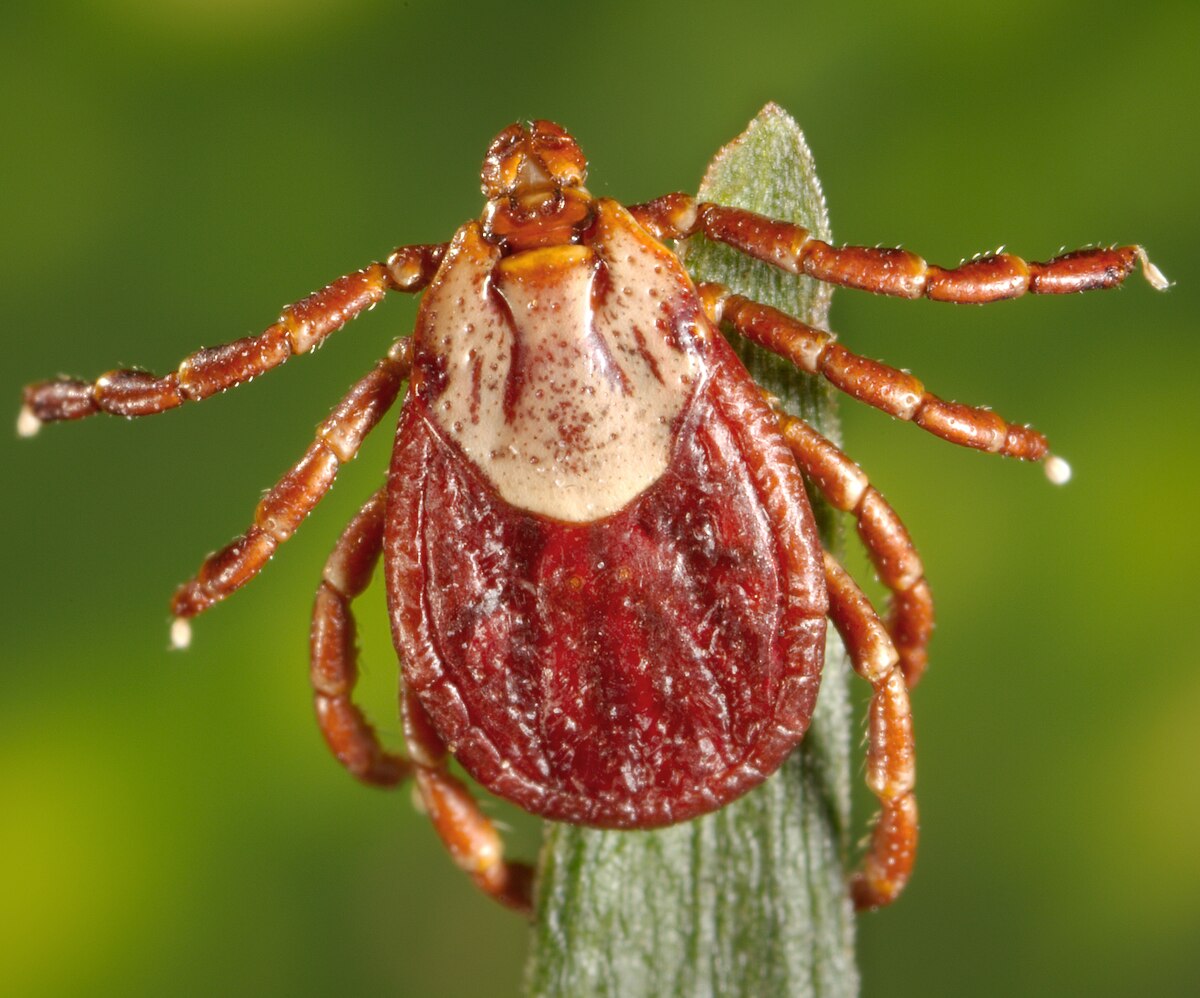
The Rocky Mountain Wood Tick is a common parasitic arachnid found in Idaho’s grasslands, forests, and shrublands. Adults are reddish-brown with a hard, oval body about 0.25 inches long when unfed but can expand dramatically after feeding. They often cling to tall grass or low vegetation, waiting for a host to pass by.
These ticks attach to humans, dogs, and other mammals to feed on blood. They are most active during spring and early summer when temperatures rise. Once attached, they feed for several days before dropping off to continue their life cycle.
The Rocky Mountain Wood Tick is a vector for several serious diseases, including Rocky Mountain spotted fever, Colorado tick fever, and tularemia. Symptoms of infection can include fever, rash, fatigue, and in severe cases, organ complications if untreated. Tick bites themselves may also cause irritation and local swelling.
In Idaho, prevention is the best defense—wearing long clothing, using insect repellent, and checking for ticks after outdoor activities can significantly reduce the risk. Prompt removal of ticks helps prevent disease transmission.
Deer Tick (Ixodes scapularis)
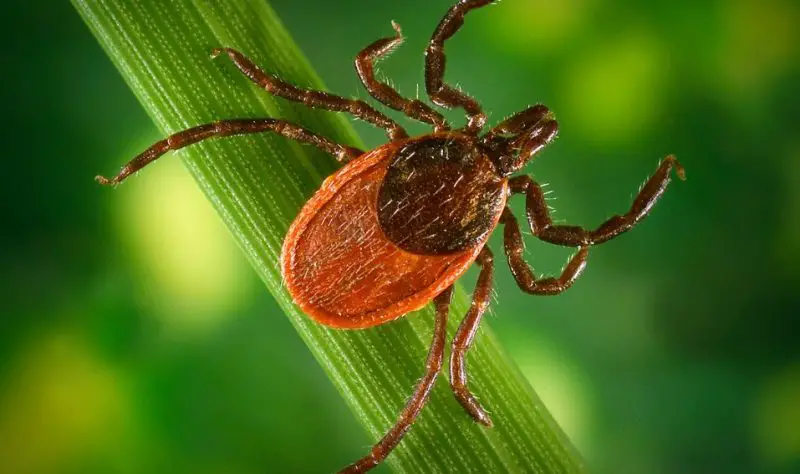
The Deer Tick, also known as the Blacklegged Tick, is smaller than most tick species, with adults measuring only about 0.1 to 0.2 inches in length. They have reddish-brown bodies and black legs, which make them easy to distinguish. This species is most commonly found in the wooded and grassy areas of northern Idaho.
Deer Ticks attach themselves to mammals, birds, and occasionally humans to feed on blood. They are particularly active in spring and fall when humidity levels are high. These ticks spend much of their time waiting on tall grass or leaf litter for a host to brush past.
They are known carriers of Lyme disease, anaplasmosis, and babesiosis. Early symptoms of Lyme disease include fever, fatigue, and the characteristic bull’s-eye rash around the bite. If left untreated, the infection can cause neurological and joint complications.
In Idaho, preventive measures include wearing protective clothing, applying tick repellents containing DEET, and thoroughly checking pets and clothing after hiking. Immediate removal of ticks with tweezers is essential to reduce the chance of infection.
Black Horsefly (Tabanus atratus)
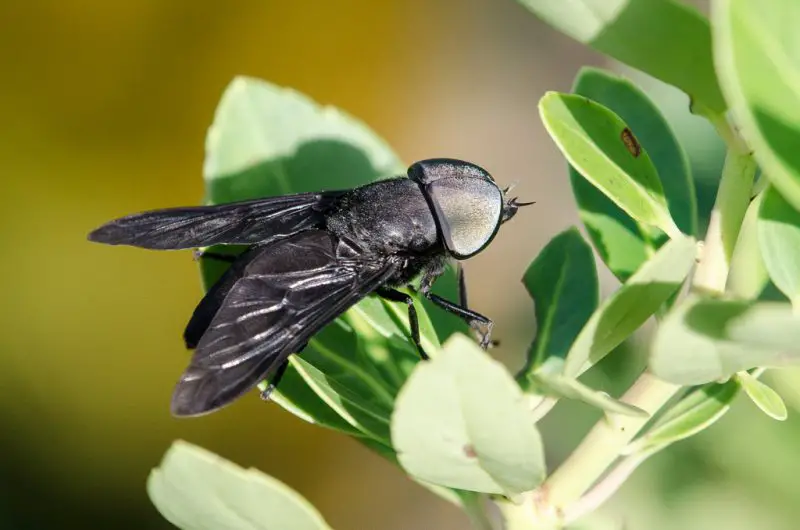
The Black Horsefly is a large, dark species found in Idaho’s forest edges and near wetlands. Females can reach nearly 1 inch in length, with shiny black bodies and large, deep-set eyes. They are powerful fliers and are often seen buzzing around livestock or shaded trails.
Female Black Horseflies require blood meals to reproduce. They use sharp, blade-like mouthparts to cut through the skin, causing severe pain and bleeding. Males, on the other hand, feed only on plant nectar. These flies are most active during sunny, humid summer days.
Their bites are not only painful but can also transmit infections to animals, such as anaplasmosis. On humans, bites result in swelling, redness, and persistent itching. Multiple bites can cause dizziness or allergic reactions in sensitive individuals.
In Idaho, they are especially common near lakes and rivers. Wearing light-colored clothing and insect repellent helps reduce the risk of bites during outdoor activities.
Wheel Bug (Arilus cristatus)
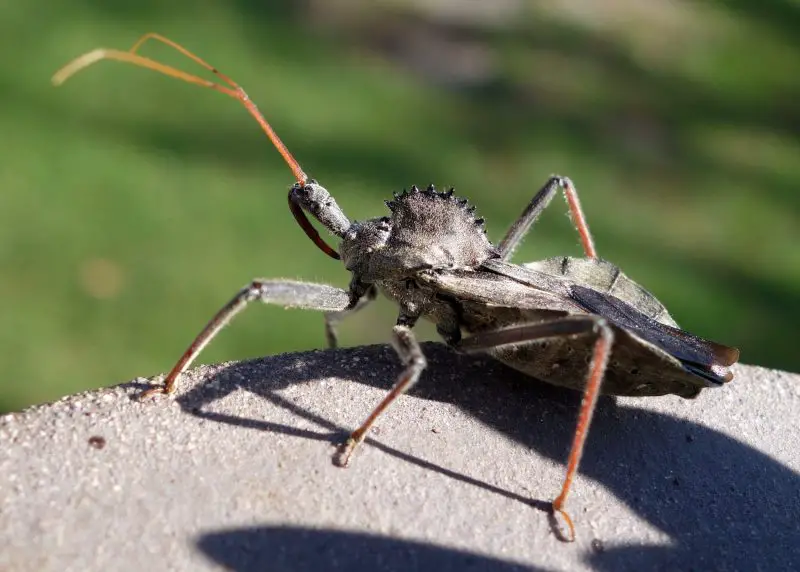
The Wheel Bug is one of Idaho’s largest assassin bugs and an impressive predator in gardens and wooded areas. It is named for the semicircular, cog-like crest on its back, which resembles a wheel. Adults are grayish-brown, about 1 to 1.5 inches long, and move slowly but strike fast.
Wheel Bugs feed on caterpillars, beetles, and other insects by piercing them with a long beak and injecting a paralyzing saliva that liquefies their insides. Though beneficial to pest control, they can inflict a very painful bite if handled.
A Wheel Bug bite causes immediate burning pain, redness, and localized swelling that may last several days. The wound can sometimes blister or become numb, but serious medical effects are rare. Despite their intimidating look, these insects are not aggressive and only bite in self-defense.
In Idaho, Wheel Bugs are most active in late summer and fall, especially around gardens and forest edges. Observing them from a distance is the safest way to appreciate their fascinating behavior.
Mosquito (Culex tarsalis)
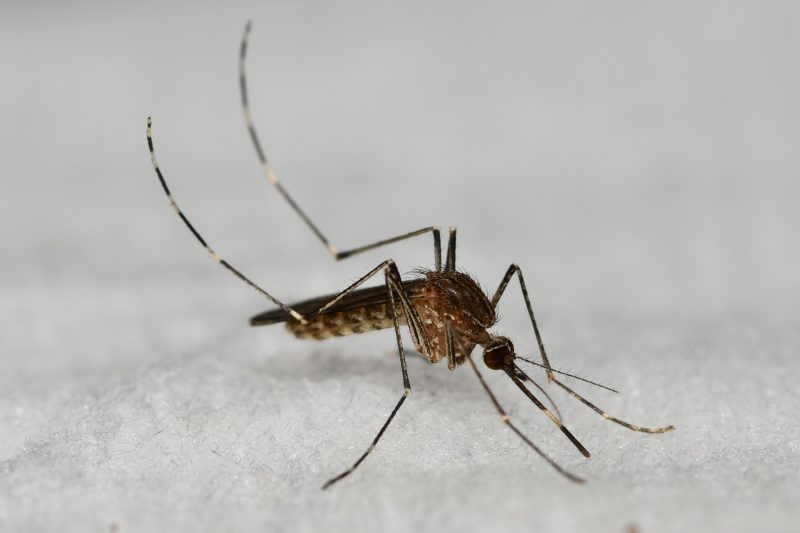
The Culex tarsalis mosquito is the most significant disease-carrying mosquito species in Idaho. It has a slender body, long legs, and scaled wings. Adults are grayish-brown with white bands on their legs and measure about 0.15 inches long. They are most active from dusk until dawn during the warm months.
This mosquito thrives near standing water, including ponds, irrigation ditches, and even small containers around homes. Females lay eggs on the water’s surface, and the larvae develop rapidly in warm temperatures. Populations peak during summer and early fall, especially in rural and agricultural areas.
Culex tarsalis is the primary vector of West Nile virus in Idaho. Infected individuals may experience fever, fatigue, headache, or in severe cases, neurological symptoms such as confusion and muscle weakness. Although most infections are mild, elderly people and those with weakened immune systems are at higher risk.
Preventing mosquito bites is key to staying safe. Using insect repellent, wearing long sleeves, and eliminating standing water around properties greatly reduce exposure. Local health authorities often monitor and control mosquito populations during active seasons.
Northern Widow Wasp (Tarantula Hawk Wasp, Pepsis formosa)
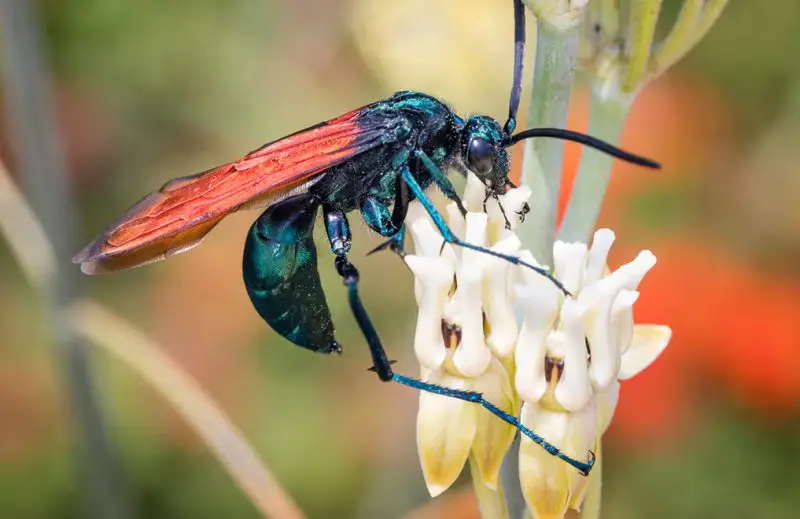
The Northern Widow Wasp, also known as the Tarantula Hawk Wasp, is one of the most venomous and painful stinging insects in North America. It is found in southern and southwestern Idaho’s desert regions and sagebrush habitats during the summer. These wasps are enormous—adults can reach up to 2 inches long—with metallic blue-black bodies and vivid orange wings.
Despite their fearsome appearance, Tarantula Hawks are solitary and usually non-aggressive. They feed on nectar and fermenting fruit, but females hunt large spiders—especially tarantulas—to serve as living hosts for their larvae. Their sting paralyzes the spider instantly, and the wasp drags it into a burrow before laying an egg on it.
The sting of a Tarantula Hawk is ranked among the most painful in the insect world—second only to the bullet ant on the Schmidt Pain Index. Victims describe it as an electric shock-like pain that can cause screaming, muscle spasms, and temporary paralysis lasting several minutes. Thankfully, the venom is not deadly to humans, and the pain fades without lasting damage.
In Idaho, Tarantula Hawks are rarely encountered but are unmistakable when seen. They play a vital role in controlling spider populations but should never be handled or provoked. Watching these powerful wasps from a distance is both safer and awe-inspiring.
Botfly (Cuterebra spp.)
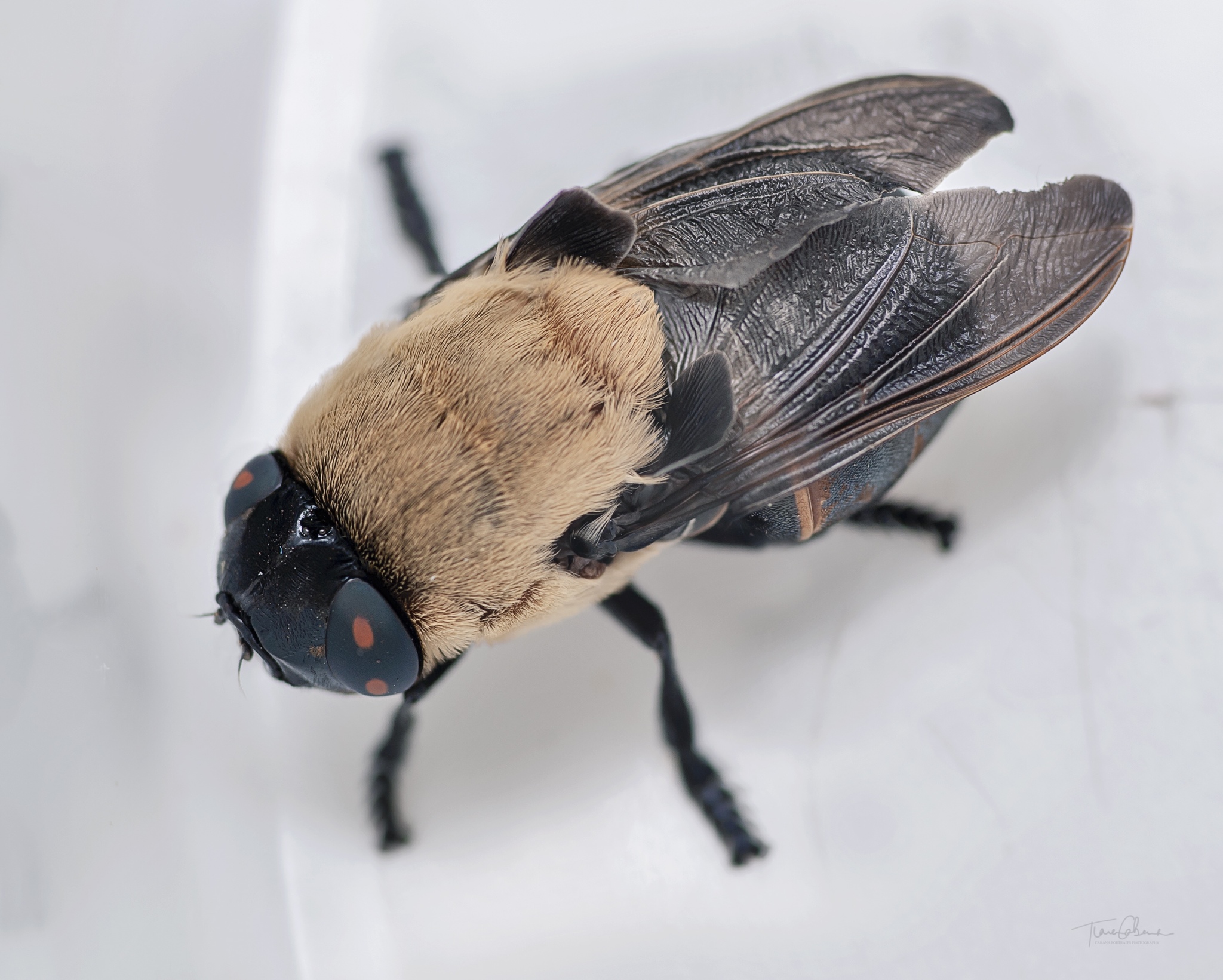
The Botfly is a parasitic insect found in Idaho’s rural and forested regions. Adult botflies resemble large bumblebees with fuzzy bodies and measure about 0.5 to 1 inch long. Although harmless themselves, their larvae are internal parasites that can infest mammals, including rodents, rabbits, and even domestic pets.
Female botflies lay eggs near animal burrows or on vegetation frequented by potential hosts. When a host brushes against the eggs, the larvae hatch and penetrate the skin, migrating beneath the surface. Once under the skin, they form a warble—a painful swelling with a small breathing hole.
Infestations cause discomfort, inflammation, and secondary bacterial infections if untreated. In pets, botfly larvae are often found around the head, neck, or body openings. Humans are rarely affected, but accidental cases have been reported, causing painful lumps that require medical removal.
In Idaho, botflies are most active during late summer and early fall. Preventing infestations involves keeping pets away from rodent habitats and inspecting them regularly. Veterinarians can safely remove larvae and treat any resulting wounds.
Assassin Bug (Kissing Bug, Triatoma spp.)
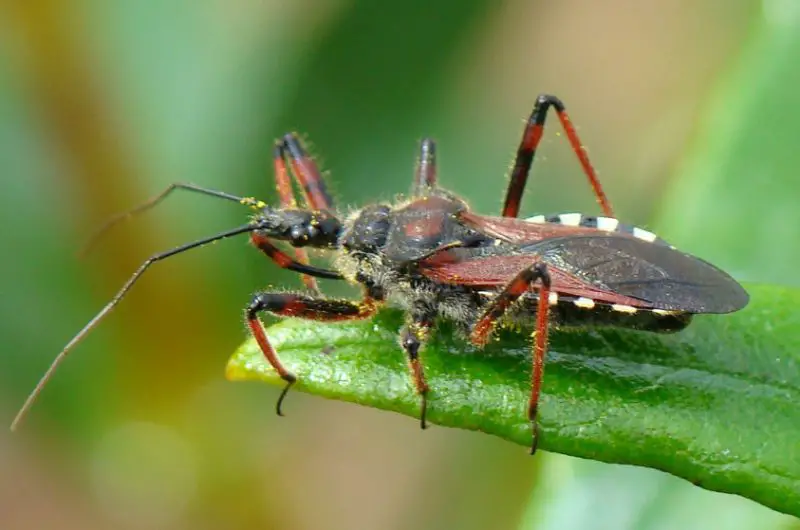
Assassin Bugs, commonly called Kissing Bugs, are rare but occasionally found in southern Idaho. They are oval-shaped insects with elongated heads, long legs, and a dark body marked with red or orange edges. Adults measure about 0.75 to 1 inch in length and are most active at night.
These insects are predatory, feeding primarily on other insects. However, some species in the Triatoma genus feed on the blood of mammals, including humans. They are called “Kissing Bugs” because they often bite near the mouth or eyes while their host sleeps.
The bite is painful and may cause swelling, itching, and allergic reactions. In rare instances, they can transmit Trypanosoma cruzi, the parasite responsible for Chagas disease, through their feces. Although the disease is not common in Idaho, isolated occurrences have been noted in nearby western states.
Kissing Bugs are typically found in warm, dry areas such as under porches, in rodent nests, or in cracks near homes. Maintaining clean surroundings, sealing entry points, and minimizing contact with rodents can help prevent encounters.
Blister Beetle (Meloidae family)
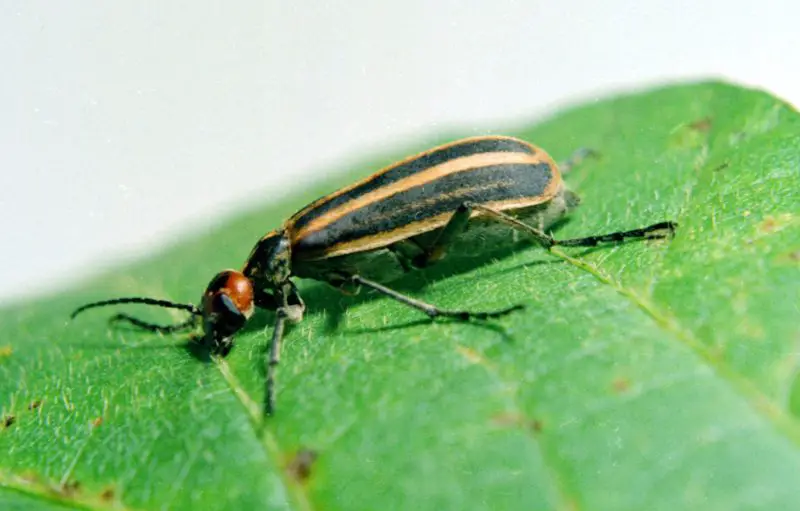
Blister Beetles are slender, soft-bodied insects found across Idaho’s grasslands and agricultural regions. They range from 0.3 to 1 inch in length and display various colors, including black, gray, or metallic green. These beetles often feed on flowers and crops, particularly alfalfa and clover.
The key danger of Blister Beetles lies in their defensive secretion—cantharidin. This oily substance causes severe skin irritation and blistering upon contact. If ingested, even a small number of beetles can be deadly to livestock, especially horses, leading to internal blistering and kidney failure.
Human contact with Blister Beetles can result in painful blisters, redness, and burning sensations on the skin. The irritation typically heals within a few days, but care should be taken to avoid spreading the toxin to the eyes or mouth. Handling them with bare hands is strongly discouraged.
In Idaho, Blister Beetles are most active in late spring and summer. Farmers should inspect hay and forage carefully before feeding it to animals. Controlling beetle populations in crop fields helps prevent accidental poisoning.
Scorpion (Paruroctonus boreus)
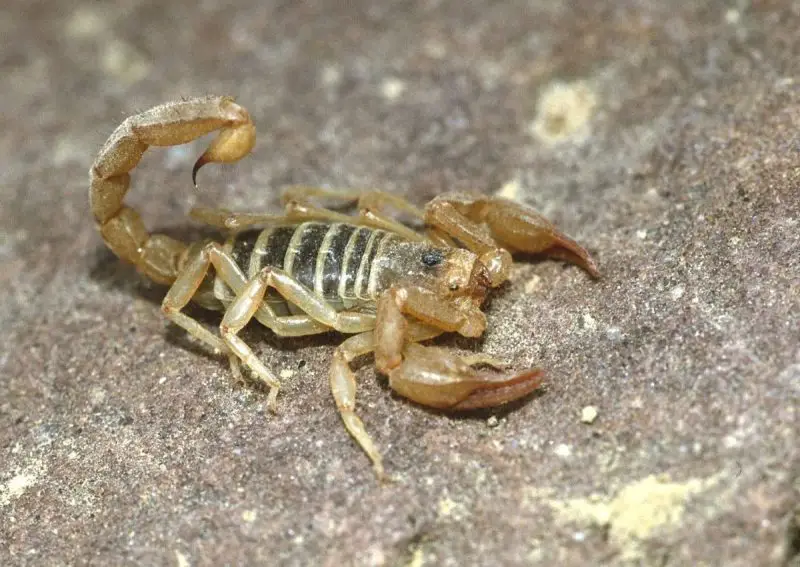
The Northern Scorpion (Paruroctonus boreus) is Idaho’s only native scorpion species. It is a small, pale-yellow to light brown arachnid, usually about 1.5 to 2 inches long. Found primarily in the desert and rocky regions of southern Idaho, this species hides under stones, logs, and debris during the day.
Scorpions are nocturnal hunters, feeding on small insects and spiders. They use their pincers to grasp prey and their stinger to inject venom. Although they appear intimidating, these scorpions are not aggressive and typically sting only when threatened or accidentally handled.
The sting of Paruroctonus boreus causes moderate pain, redness, and localized swelling similar to a bee sting. Symptoms usually subside within a few hours, though individuals allergic to venom may experience more intense reactions. No fatalities have been recorded from this species in Idaho.
These scorpions play an important role in the desert ecosystem by keeping insect populations in check. In Idaho, they are most active on warm summer nights. Avoiding nighttime rock-turning and wearing gloves when exploring rocky terrain can help prevent stings.
Centipede (Chilopoda class)
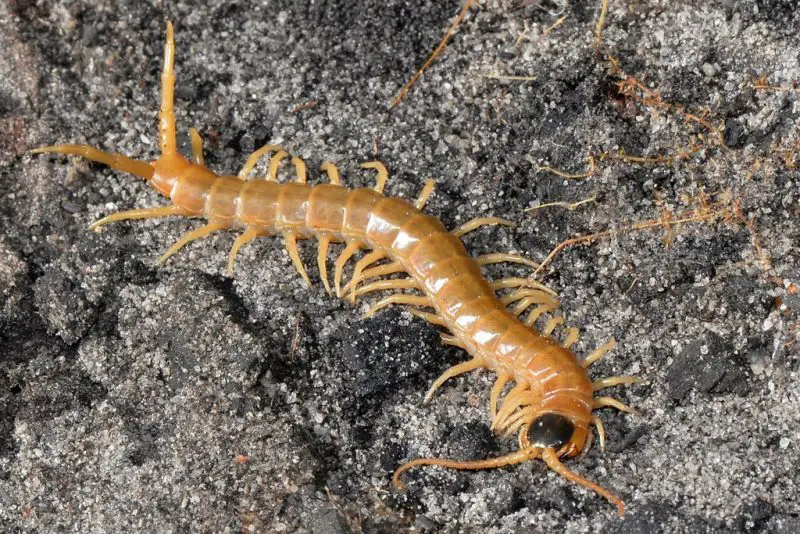
Centipedes are long, flattened arthropods with many body segments, each bearing a pair of legs. In Idaho, species range from small house centipedes just an inch long to larger desert species exceeding 3 inches. They are typically reddish-brown or yellowish, with a shiny, segmented appearance and swift, darting movements.
Centipedes are nocturnal predators that feed on insects, spiders, and other small invertebrates. They prefer damp, dark environments such as under rocks, leaf litter, and inside basements or bathrooms. Their front legs are modified into venomous forcipules, which they use to immobilize prey.
While centipede bites are rare, larger species can deliver a venomous bite that causes immediate, burning pain, redness, and swelling. The discomfort may last several hours, and in rare cases, nausea or headache can occur. The bites are not lethal but can be quite distressing.
In Idaho, centipedes are most active during the warm months. They play a beneficial role by controlling other pest populations but can become a nuisance indoors. Sealing entry points and reducing moisture levels can help prevent infestations.
Giant Water Bug (Lethocerus americanus)
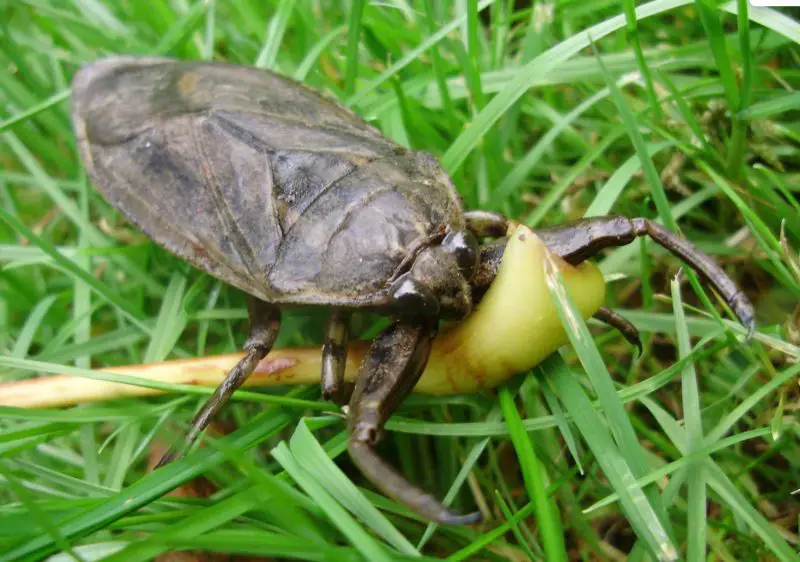
The Giant Water Bug, commonly called the “Toe-biter,” is one of the largest true bugs in Idaho. Adults can reach up to 2.5 inches in length, with a flat, brown body and raptorial front legs adapted for grasping prey. They are often mistaken for beetles but are actually aquatic insects.
These bugs inhabit ponds, lakes, and slow-moving streams, where they ambush fish, tadpoles, and other insects. They breathe through a small air tube at the end of their abdomen and are strong swimmers. During mating season, they are attracted to lights, often appearing on porches and around outdoor lamps.
Despite lacking venom, Giant Water Bugs deliver one of the most painful bites of any insect in North America. Their piercing mouthparts inject digestive enzymes that cause intense, burning pain and swelling, sometimes lasting several hours. The bite can even draw blood, earning them their nickname.
Although not medically dangerous, these insects should be handled with care or avoided entirely. In Idaho, they play an important ecological role in aquatic environments by regulating insect and small fish populations.
Fire Ant (Solenopsis invicta)
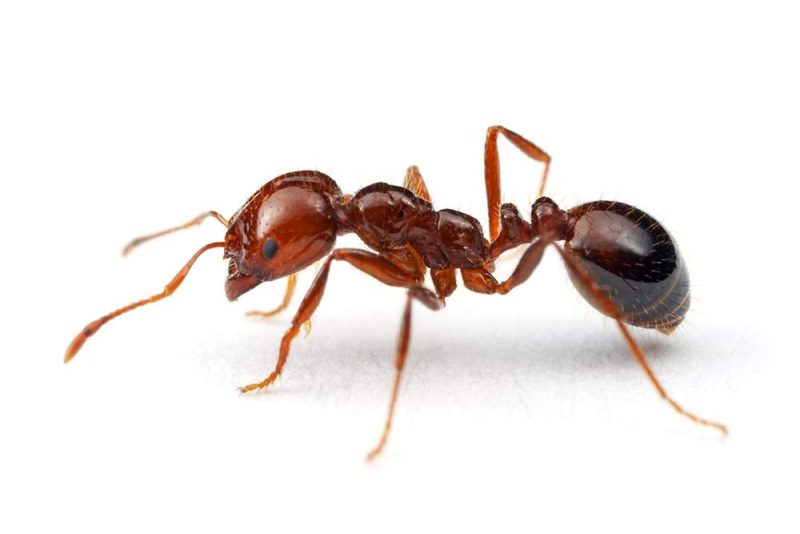
The Fire Ant is not native to Idaho but has occasionally been introduced through imported soil, nursery plants, or shipments. These small, reddish-brown ants measure around 0.1 to 0.25 inches long and live in large, aggressive colonies. Their mounds are dome-shaped and can appear in disturbed soil or grassy areas.
Fire Ants are highly territorial and will swarm quickly when their nest is disturbed. They latch onto their target with mandibles and repeatedly sting with their venomous stingers. The stings cause an immediate burning sensation, followed by itching, redness, and the formation of white pustules.
For sensitive individuals, multiple stings can cause allergic reactions, dizziness, or even anaphylaxis. Though they are uncommon in Idaho’s colder climate, vigilance is important to prevent establishment, especially in greenhouses or imported soil environments.
When Fire Ants are found, professional pest control should be contacted immediately. Avoiding contact and keeping soil shipments inspected are key preventive measures in Idaho’s ecosystems.
Flea (Ctenocephalides spp.)
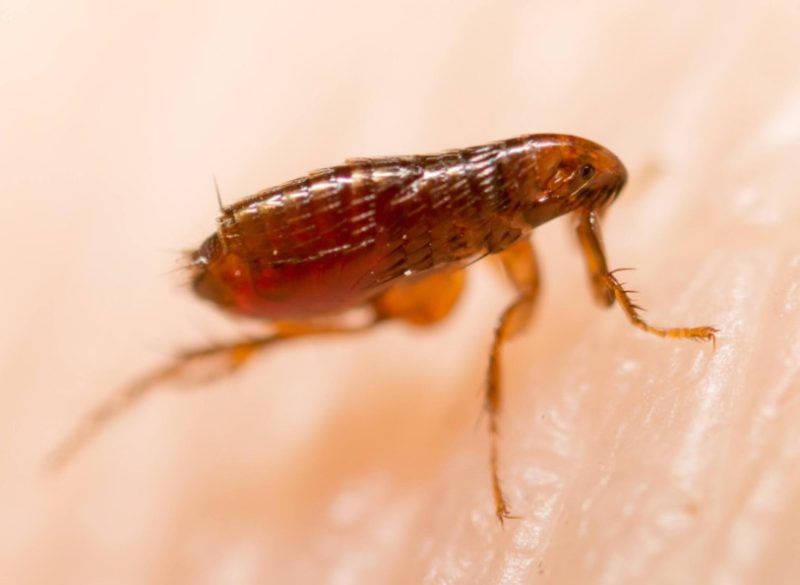
Fleas are tiny, wingless insects that feed on the blood of mammals and birds. They are about 1/8 inch long, reddish-brown, and equipped with strong hind legs that allow them to jump great distances. In Idaho, fleas commonly infest pets, wildlife, and sometimes human dwellings.
These pests thrive in warm, humid environments and can be found in bedding, carpets, and pet resting areas. Fleas reproduce rapidly—females can lay hundreds of eggs during their lifetime—making infestations difficult to control once established.
Flea bites cause small, red bumps surrounded by itchy halos, usually appearing on the legs or ankles. Heavy infestations may lead to allergic dermatitis in pets and humans. Fleas can also transmit diseases such as murine typhus and tapeworms, posing a health concern for households.
Controlling fleas in Idaho involves regular pet grooming, vacuuming, and the use of veterinarian-approved flea preventatives. Maintaining clean living conditions helps break the flea life cycle and prevent re-infestations.
Bed Bug (Cimex lectularius)
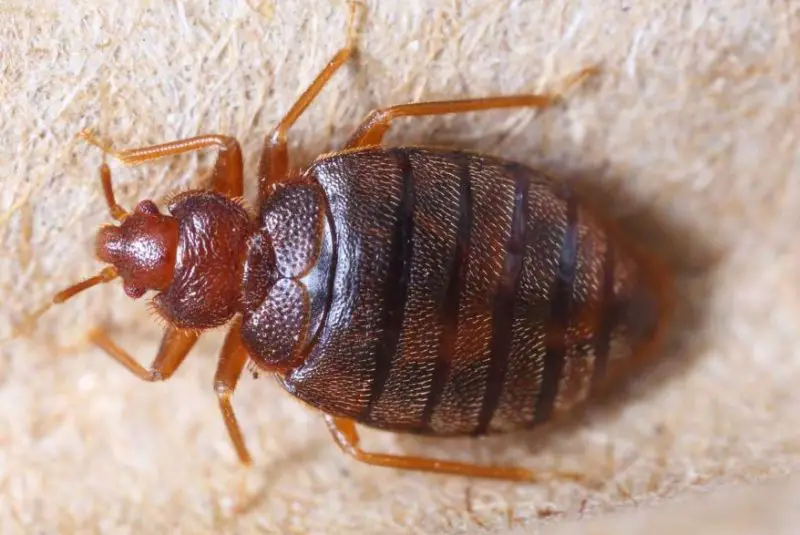
Bed Bugs are small, reddish-brown insects that feed exclusively on blood. Adults are flat and oval-shaped, about 0.25 inches long, becoming swollen and darker after feeding. In Idaho, they are commonly found in hotels, apartments, and residential homes, particularly in bedding and furniture seams.
These pests are nocturnal and feed on sleeping hosts, usually biting exposed skin areas such as the arms, neck, or face. Their bites appear as clusters or rows of red, itchy welts. Bed Bugs do not transmit diseases, but their presence can cause allergic reactions, skin irritation, and significant anxiety.
Infestations spread quickly through luggage, clothing, or used furniture. Because they hide in cracks and crevices during the day, detecting and eradicating them can be challenging. Professional heat treatments and chemical control are often required for complete elimination.
In Idaho, Bed Bug cases have increased with travel and population growth. Regular inspection of bedding and vacuuming can help prevent infestations. Washing linens in hot water also helps kill eggs and nymphs.
Western Black-legged Tick (Ixodes pacificus)
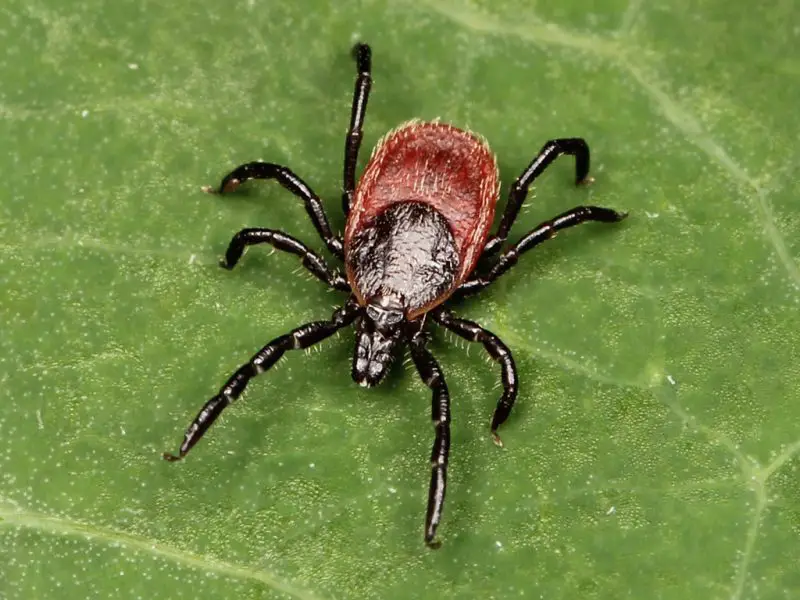
The Western Black-legged Tick is a close relative of the Deer Tick and is found primarily in Idaho’s forested regions and along the western border. Adults are small, with reddish-brown bodies and black legs, measuring about 0.1 to 0.2 inches in length. They prefer humid environments with dense vegetation.
These ticks attach to mammals, birds, and occasionally humans to feed on blood. They are most active in spring and fall, waiting on grass or shrubs to latch onto passing hosts. Once attached, they can remain for several days while feeding.
This species is a known vector for Lyme disease, babesiosis, and anaplasmosis. Symptoms from tick bites may include fever, fatigue, and the characteristic bull’s-eye rash in Lyme infections. Early diagnosis and antibiotic treatment are essential to prevent long-term health issues.
In Idaho, wearing long clothing, using tick repellents, and performing full-body checks after outdoor activities can help prevent bites. Clearing brush and keeping lawns trimmed also reduce tick habitats.
Tips for Staying Safe from Dangerous Bugs in Idaho
1. Wear Protective Clothing Outdoors
When hiking, camping, or working in wooded or grassy areas, wear long sleeves, long pants tucked into socks, and closed-toe shoes. Light-colored clothing helps you spot ticks or other insects before they bite. In desert areas, boots are essential to avoid scorpion stings.
2. Use Insect Repellents Effectively
Apply EPA-approved repellents containing DEET, picaridin, or oil of lemon eucalyptus. These products help repel mosquitoes, ticks, and biting flies. Always reapply after swimming or sweating.
3. Inspect Yourself and Pets After Outdoor Activities
Ticks in Idaho are active from early spring through late fall. After being outside, check your body, scalp, and clothing carefully. Also inspect pets, as ticks often latch onto fur and may enter the home.
4. Keep Your Home and Yard Clean
Remove clutter, woodpiles, and standing water—common hiding or breeding sites for spiders, mosquitoes, and hornets. Regularly clean basements and garages to prevent infestations from hobo spiders or black widows.
5. Avoid Disturbing Nests and Hiding Spots
Yellowjackets, hornets, and paper wasps are territorial and attack if disturbed. Never attempt to remove a nest on your own; contact professional pest control. Likewise, avoid turning over rocks or logs in desert areas where scorpions may hide.
6. Know First Aid for Bites and Stings
For most stings, wash the area with soap and water, apply a cold compress, and use an antihistamine to reduce swelling.
Seek immediate medical care if you experience shortness of breath, dizziness, muscle cramps, or signs of infection after a bite.
7. Keep Screens and Entry Points Sealed
Ensure windows and door screens are intact. Repair cracks or gaps around doors and pipes to keep spiders and insects from entering your home.
FAQs About Dangerous Bugs in Idaho
Are there poisonous spiders in Idaho?
Yes. The Black Widow Spider is the most venomous spider in Idaho, and the Hobo Spider may cause painful bites. The Brown Recluse is rare but occasionally reported in southern Idaho.
Do scorpions live in Idaho?
Yes. The Northern Scorpion (Paruroctonus boreus) lives in Idaho’s arid southern and western regions. Its sting is painful but not usually life-threatening.
Can you get Lyme disease in Idaho?
Yes, though rare. Both Deer Ticks and Western Black-legged Ticks in northern Idaho can carry Lyme disease. Prompt removal of ticks (within 24 hours) drastically reduces risk.
What is the most painful insect sting in Idaho?
The Velvet Ant (Cow Killer Ant) is notorious for having one of the most painful stings in North America. Although it’s not deadly, the pain can last up to 30 minutes.
Are mosquitoes in Idaho dangerous?
Yes. Culex tarsalis mosquitoes can carry West Nile virus, which appears in Idaho nearly every summer. Use repellents and eliminate standing water to minimize risk.
Do fire ants live in Idaho?
They are not native but have occasionally been found in imported soil or garden plants. While not established, they are still considered a potential invasive threat.
What should I do if bitten by a Black Widow spider?
Clean the bite area, apply ice, and seek medical attention immediately. Antivenom may be needed if symptoms like muscle cramps, nausea, or sweating occur.
How can I identify a Hobo Spider?
Hobo Spiders are medium-sized brown spiders with no distinct dark markings on their abdomen. They’re often found in basements, garages, or window wells.
Are wasps and hornets aggressive in Idaho?
Yes. Yellowjackets and Bald-faced Hornets become especially aggressive in late summer and fall. Avoid their nests and cover food and drinks outdoors.
Which bug causes blisters if touched?
The Blister Beetle releases a toxic chemical called cantharidin, which can cause severe skin blistering. Never handle these beetles with bare hands.
Are centipedes venomous?
Yes, but their venom is not fatal to humans. Large centipedes in Idaho can deliver painful bites causing redness and burning that may last several hours.
How can I protect my pets from Idaho’s dangerous bugs?
Use veterinarian-approved tick and flea preventives, keep your yard trimmed, and avoid letting pets roam through tall grass or woodpiles where ticks and spiders may hide.


